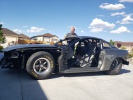So I believe what he means is to calculate the percent of change and then multiply it by the whole table. For example:
My new normal value is 6.41
So I take 6.41 / 5.55 = 1.154 (That's a 15.4% increase across the entire table)
So the new values become:
newnormalvalues.JPG
However he made reference that at lower temperature values that the air is more dense and those the change doesn't have to be as drastic, so I am assuming you could actually multiply by the percent you get above for temp ranges of 154*F and up, and maybe by 8% for the lower boundaries.





 Reply With Quote
Reply With Quote